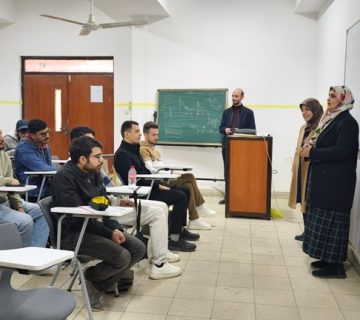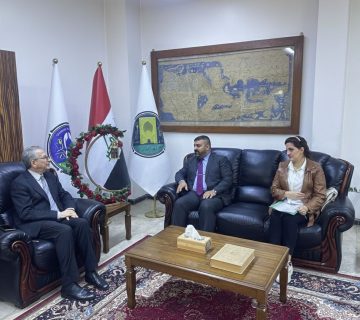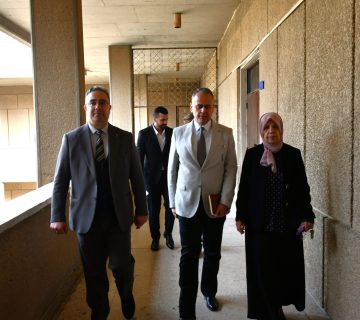It was conducted on Wednesday, 24/4/2024, in Dr. Ihsan Yahya Hussein Hall the discussion of the PhD Dissertation of the student AHMED KHALEEL ABDULAMEER, which is tagged:
“Analysis, Design, and Manufacturing of a Semi-active Knee Prosthesis “.
The discussion committee consisted of names listed below:
1 Prof. Dr. Majid H. Faidh-Allah (Chairman).
2- Prof. Dr. Kadhim K. Resan (Member).
3- Asst. Prof. Dr.Waleed K. khairi (Member).
4- Asst. Prof. Dr. Karim H. Ali (Member).
5- Asst. Prof. Dr. Thaier J. Ntayeesh (Member).
6- – Prof. Dr. Mohsin A. Al-Shammari (Supervisor).
The current study aims to design and manufacture a magnetorheological damper-based prosthetic knee that features a lightweight, and affordable cost capable of mimicking the human knee joint as closely as possible so that the amputee feels comfortable. The work is divided into four stages: First, the mechanical design phase involves creating a microprocessor-controlled prosthetic knee using SolidWorks, according to the design criteria. Second, structural analysis was conducted using ANSYS Workbench to assess its durability and stability. The third stage involved manufacturing the knee prosthesis utilizing a CNC machine. Lastly, an electronic control system for a magnetorheological damper-based prosthetic knee was designed and validated, with performance evaluation conducted by an above-knee amputee.
The mechanical components of a microprocessor-controlled prosthetic knee comprise the frame, hinge joint, pyramid adaptors, sex bolts, needle bearing, and washers. Frame, and hinge joints, are designed and manufactured from aluminum 2024T3, while sex bolts are manufactured from steel (AISI1020) respectively.
The structural analysis of a microprocessor-controlled knee prosthesis is conducted during the stance phase specifically at the (13%) of the midstance phases of the gait cycle for a 100 kg maximum mass of an amputee.
The ON-OFF control system is designed to regulate the current flowing in the magnetorheological damper by varying the values of the voltage, thus controlling the damping force of the damper. Two types of sensors were used; a plantar insole pressure sensor to measure the ground reaction force along the foot, and a slide potentiometer to measure the knee angle during the gait cycle.
The knee angle and ground reaction force are input variables for the microprocessor-controlled prosthetic knee, where the controller which in turn analyzes the signal received from these sensors and sends a signal to the pulse width modulation fed to MOSFET, which is employed as a switch; thus, controlling the pulse width modulation voltage at its gate.
The results of the structural analysis showed that the prototype of a magnetorheological damper-based prosthetic knee is safe from mechanical failure. It is found that the maximum stresses occur in the lower holes of the frame recording (23.151) MPa, while in the case of the hinge joint, the maximum stresses in the upper segment of the holes that link the hinge joint with the magnetorheological damper registering a maximum stress level of (16.309) MPa.
The components of the MR damper-based prosthetic knee were selected carefully to produce an optimum model with 246 mm length and 1.55 kg mass, as well as its affordable cost. Despite the simplicity of the control system, it has proven its effectiveness when it comes to walking on level terrain. The performance of the control system for microprocessor-controlled knee prosthesis was experimentally validated by the case study subject by walking on the treadmill (the Zebris device) at different speeds to analyze the gait cycle. It was found that the patient’s cycle time, cadence, and stride length at speeds of 0.833 m/s were approximately (1.3) sec, (92) steps/min, and (1.06) m respectively. These findings closely align with their counterparts observed in healthy individuals of the same age and speed during the gait cycle.
After the scientific discussion by the members of the discussion committee, the researcher received a rating of (Excellent).







